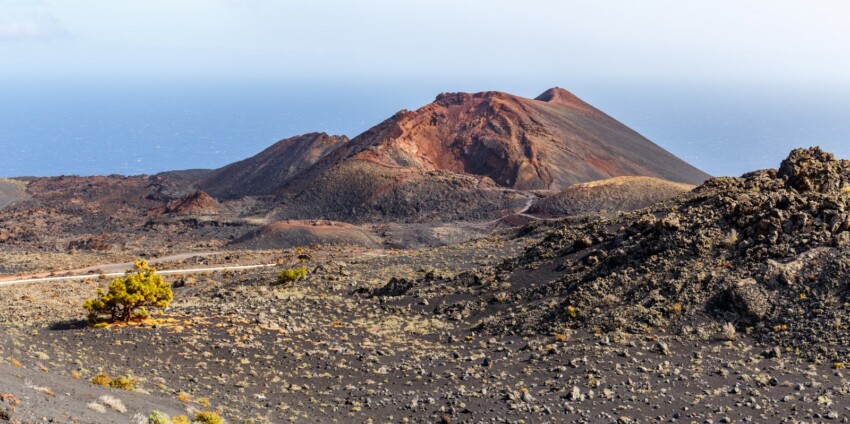

Among the lesser known of the Canary Islands archipelago, and therefore far from mass tourism, the volcanic island of La Palma, also known as the Green Island, is a kaleidoscope of natural environments.
Beautiful black sand beaches, picturesque villages, laurel forests, pine forests, volcanic landscapes, deep gorges and colonial-style villages will make your holiday unforgettable.
Santa Cruz de la Palma, the capital of the island, has a small historic centre where you can admire beautiful Renaissance palaces and excellent handicraft shops, including cigar shops made from local tobacco.
Very pretty traditional villages include Santo Domingo de Garafia, on the northern coast, and Los Llanos de Aridane.
La Palma, declared a Unesco Biosphere Reserve in 2002, is a veritable continent in miniature and is home to the marvellous Caldera de Taburiente National Park, where an enormous volcanic crater 8 kilometres in diameter and 770 metres deep is located, and the important Garafia astrophysical observatory.
Among the most famous black sand beaches are Puerto Naos, El Charco Verde in Los Llanos de Aridane, El Volcán in Tazacorte, Playa de la Zamora in Fuencaliente, Los Cancajos in Breña Baja and Nogales in Puntallana.
The highest mountain in La Palma, Roque de los Muchachos, reaches 2,426 metres above sea level.

Santa Cruz, the capital of La Palma, is located along the east coast of the island, on the edge of the volcanic crater, around a bay protected from the winds and suitable for the landing of ships. Founded on 3 May 1493 by Alonso Fernández de Lugo, it was an important port on the route between Europe and the colonies of the Americas. Today it is a site of historical and artistic interest, its churches housing a remarkable collection of Flemish religious art.
This beautiful colonial town boasts beautiful 16th and 17th century buildings and structures typical of the Canarian architectural tradition famous for their wooden balconies. Also of note are the religious buildings including the Santuario de Nuestra Señora de Las Nieves and the Church of San Francisco.
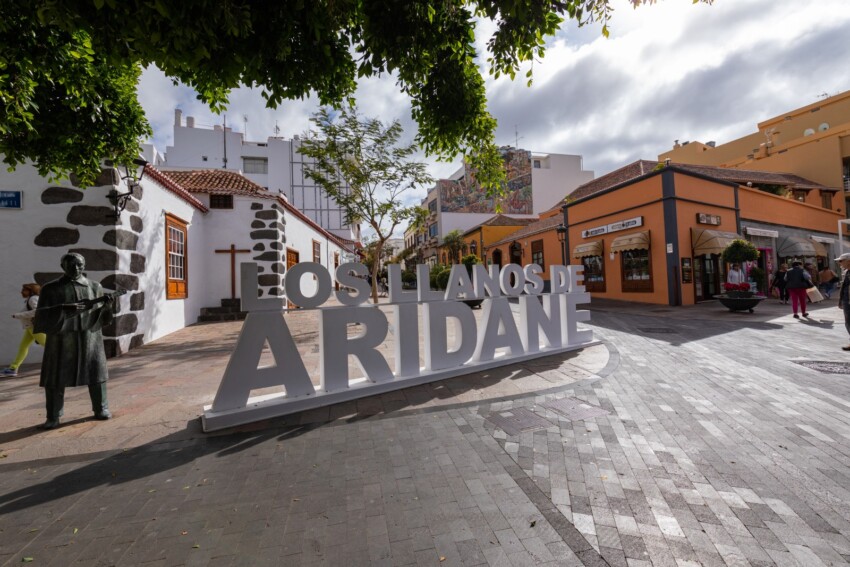
Los Llanos de Aridane is located on the western side of La Palma and is the second most important centre on the island after the capital Santa Cruz de la Palma.
In the old town you will find numerous examples of typical Canary Island architecture, including the Town Hall building, designed by architect Machado, which stands out for its façade almost inlaid with beautiful balconies.
The Iglesia Nuestra Senora de Los Remedios, dating back to the 16th century, is among the most fascinating examples of Arab architecture in the Canary Islands, while Plaza de Esapna, the beating heart of Los Llanos de Aridane, is surrounded by beautiful historical buildings.
The city’s Museum of Contemporary Art and the Benahoritas Archaeological Museum are cultural landmarks throughout the island of La Palma.
The city, the most populous on the island, has developed on a small plateau and includes large cliffs, black sand beaches and rocky coves. Among the most famous beaches are Playa de Puerto Naos and El Charco Verde, but the rocky beach of Bombilla, El Remo and Cala de Las Monjas are also worth a visit.
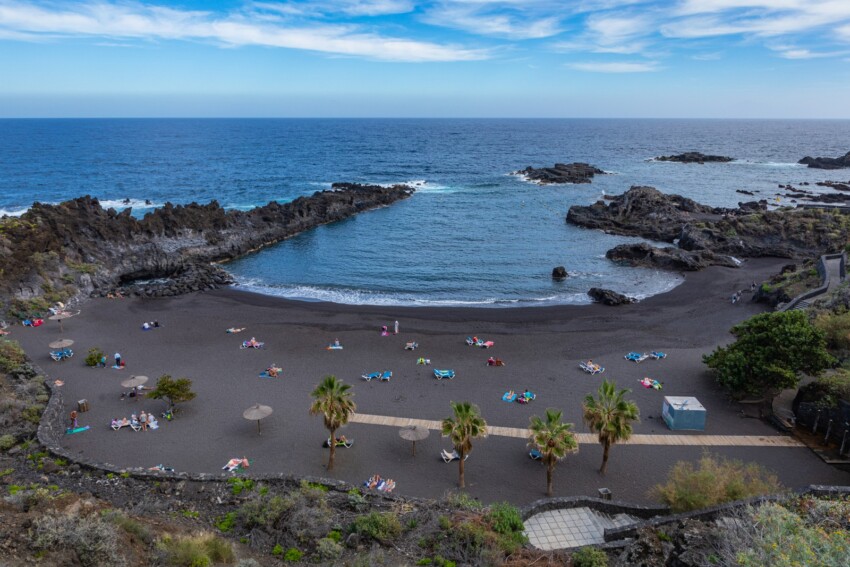
Los Cancajos, La Palma’s most famous resort, is located along the east coast of the island between the capital Santa Cruz de la Palma and La Palma Airport, both of which can be reached in a few minutes.
This tranquil resort has developed around the 3 beautiful beaches of fine black volcanic sand, sheltered from the current by an artificial dam, which have as their backdrop the dramatic mountain range enclosed by the Caldera de Taburiente national park and overlooking the neighbouring islands of Tenerife and La Gomera.
Numerous hotels, tapas bars and restaurants can be found along the main street and on the promenade of Los Cancajos.
Playa de los Cancajos is also one of the best places in La Palma for diving and snorkelling.
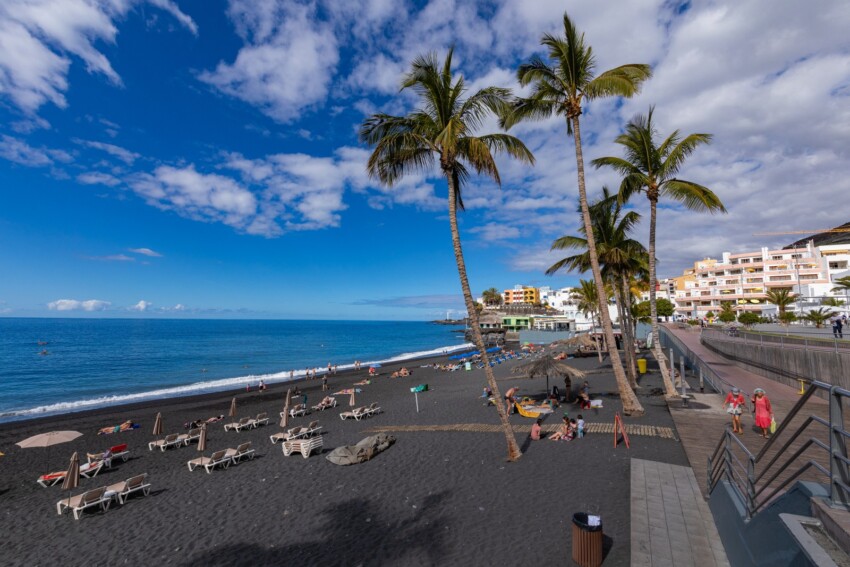
Puerto Naos is the main tourist centre on the west coast of the island of La Palma.
This resort has developed around the beautiful black volcanic sand beach lined with palm trees from which it takes its name and is famous for its spectacular sunsets.
The village of Puerto Naos not only fulfils the expectations of beach lovers but also offers excellent opportunities for walking, mountain biking, boat trips, paragliding and diving.
Several cafés, tapas bars and small restaurants serve the village and a large hotel complex and several residential areas satisfy even the most demanding guests.
Numerous charming beaches can be found along the west coast of La Palma, including the unmissable Playa Tazacorte and Playa de las Monjas. Don’t miss a sunset boat trip to Cueva Bonita, a beautiful cave that is illuminated when the sun goes down.
Puerto Naos is 45 minutes from La Palma Airport and 20 minutes from Los Llanos de Aridane and the Caldera de Taburiente National Park.
The traditional village of Fuencaliente is located in the southern part of La Palma, 23 kilometres southwest of the capital Santa Cruz de la Palma, nestled in a rugged and contrasting terrain shaped by numerous volcanic eruptions.
The volcanic ridge of Cumbre Vieja dominates Fuencaliente’s landscape of vineyards and banana groves. A 30-minute walk will take you to the astonishing craters of the Tenguia volcano or you can reach the lighthouse along the southern coast from where you can admire spectacular views of the nearby islands of El Hierro and La Gomera.
Sea lovers should not miss Playa de Echentive, where there was once a thermal spring.
The municipality of San Andrés y Sauces, comprising the villages of Los Sauces and San Andres, is located along the north-east coast of the island of La Palma, 14 kilometres north of the capital Santa Cruz de La Palma, surrounded by fertile countryside and deep gorges.
Small cobbled streets, overlooked by houses with typical Canarian architecture, run through the charming historic centre of the beautiful village of San Andres where, among other things, the 16th century Church of St. Andrew the Apostle, one of the oldest in La Palma, can be admired. Paintings and sculptures from the Flemish Renaissance can be found in the Church of Los Sauces.
Not far away is one of the most important laurel forests in the Canary Islands, the Forest of Los Tilos, located within the Las Nieves park, the natural pools of El Charco Azul, the numerous caves of the Barranco de San Juan, in particular the Tendal Cave and the Cuevas de los Murciélagos, and the charming little fishing village of Puerto Espindola.
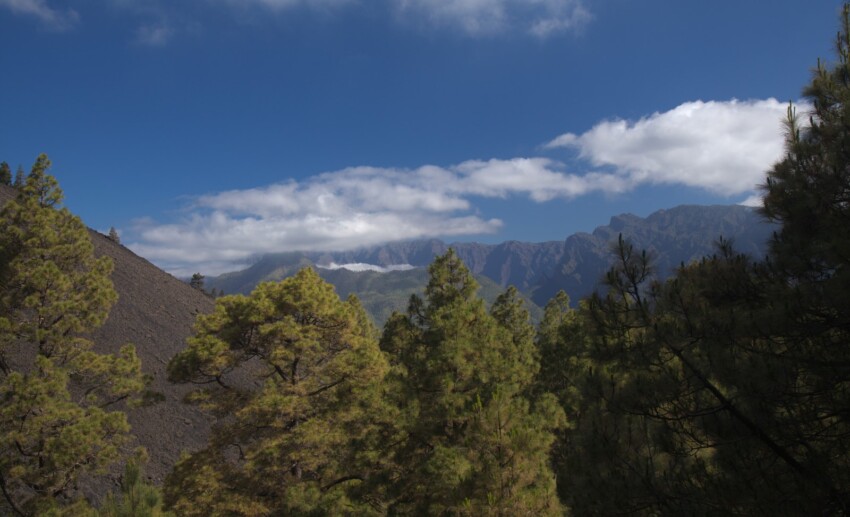
The Caldera de Taburiente National Park encloses the immense depression of the volcano, with a diameter of about 8 kilometres, within which rise the highest peaks of the island of La Palma, such as El Roque de los Muchachos, which reaches 2,000 426 metres above sea level, and Pico de la Cruz, 2,000 351 metres high.
Very steep and criss-crossed by numerous streams and waterfalls, the Park was established in 1954 and covers some 47 square kilometres with elevation differences of 2 thousand metres and rock faces of up to 800 metres.
The paths available to visitors are numerous and wind through Canary Island pine forests, breathtaking gorges, the most important of which is the Barranco de las Angustias, which stretches for 8 kilometres, and imposing lava masses of the most diverse shapes such as the Roque Idafe.
The park has a visitor centre that houses a permanent exhibition of the park’s flora, fauna, geology and history.
Don’t miss the Brecitos viewpoint, the Angustias torrent and the Cumbrecita viewpoint, all accessible by car.
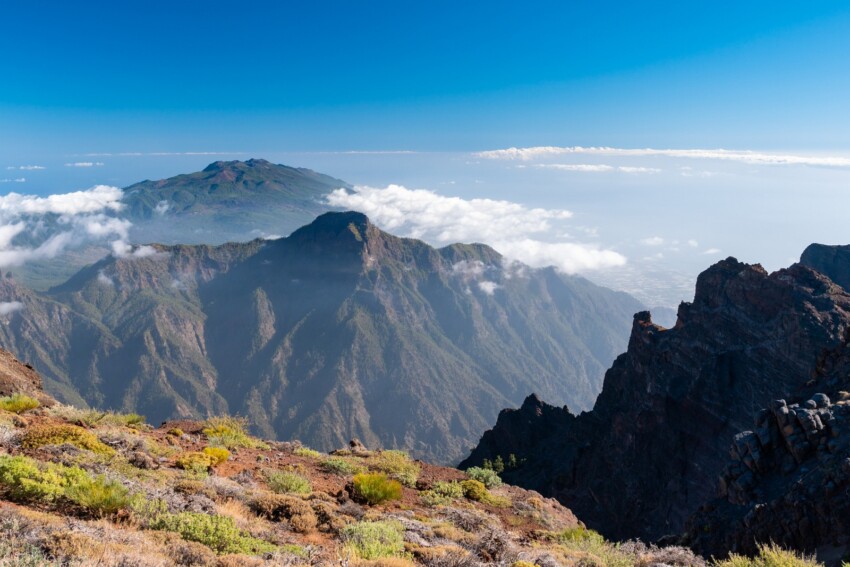
As a closer look at the Caldera de Taburiente National Park, visit the Roque de los Muchachos . This mountain represents the highest point in La Palma and is one of the best places in the world for stargazing, as the sky is practically never covered by clouds, so much so that one of the largest telescopes in the world has been built.
This area, declared a National Park, is an absolute must for anyone going to La Palma. For those suffering from vertigo, however, it is best to prepare in advance, but the visual spectacle will more than repay the effort! On a cloudless day, don’t forget to take a photo of Tenerife, La Gomera and El Hierro on the horizon.
The town of Villa de Mazo is located in the south-eastern part of the island of La Palma, between Breña Baja and the lava of the Volcano de Martín, 9 kilometres south of the capital Santa Cruz de la Palma and east of La Palma Airport.
The historical centre of the city boasts a vast historical and artistic heritage. Pedro Pérez Díaz Square, the heart of the town, houses the town hall and the neoclassical municipal library. Also very beautiful is the Casa Roja, an early 20th century building in perfect Canarian style.
In Mazo is the Belmaco Cave, one of the most important archaeological sites on the island. This cave complex, which also includes a small visitor centre, houses important rock engravings dating back to the pre-Hispanic peridot.
From Morro Mojino on the outskirts of Villa de Mazo there is a magnificent view of the sea.
Among the best excursions on the island of La Palma, the Los Tilos gorge is home to one of the most important laurel forests in the Canary Islands, declared a World Biosphere Reserve by Unesco in 1983.
This protected area of great beauty extends over 511 hectares in the northeast of La Palma between the municipalities of Barlovento, San Andres, Puntallana and Santa Cruz de La Palma.
On the route, which starts at the visitors’ centre, you will discover the subtropical rainforest, hundreds of plant species unique to the island and the magnificent Marcos y Cordero springs.
The town of El Paso is located in the western part of the island of La Palma, in the Aridane Valley, and is famous for its silk manufacturing.
The city is located at 644 metres, between two natural parks, and is surrounded by the Bejenado, Cumbre Nueva and part of Cumbre Vieja mountains. The Caldera de Taburiente National Park is an ideal destination for hikers and cyclists.
Surrounded by almond and fruit orchards, El Paso is surrounded by panoramas shaped by the force of the volcano of unparalleled beauty that can be appreciated from the La Cumbrecita view point and the Pico Bejenado, from which there is an excellent view of the Caldera.
In the centre of the city is the Pino de la Virgen, an imposing 100-year-old pine tree.
Not far from El Paso are some of the best beaches in La Palma, such as Puerto de Tazacorte, Los Cancajos and Puerto Naos.
The village of Barlovento is located in the north-eastern part of La Palma near some of the most beautiful natural pools on the island and a rich natural heritage that attracts many tourists every year.
Barlovento, surrounded by lush and fascinating nature, has developed on a plateau 548 metres above sea level and boasts an important 16th century religious building, the Church of Nuestra Senora del Rosario.
Major attractions include the volcanic crater of La Laguna, the Piscinas de la Fajana, El Charco Azul and the Mirador de La Tosca, which boasts a panoramic view of the entire northern part of the island of La Palma.
Hotels are few but numerous rural houses can be rented for your holiday.
In the following map you can see the location of the main places of interest mentioned in this article.